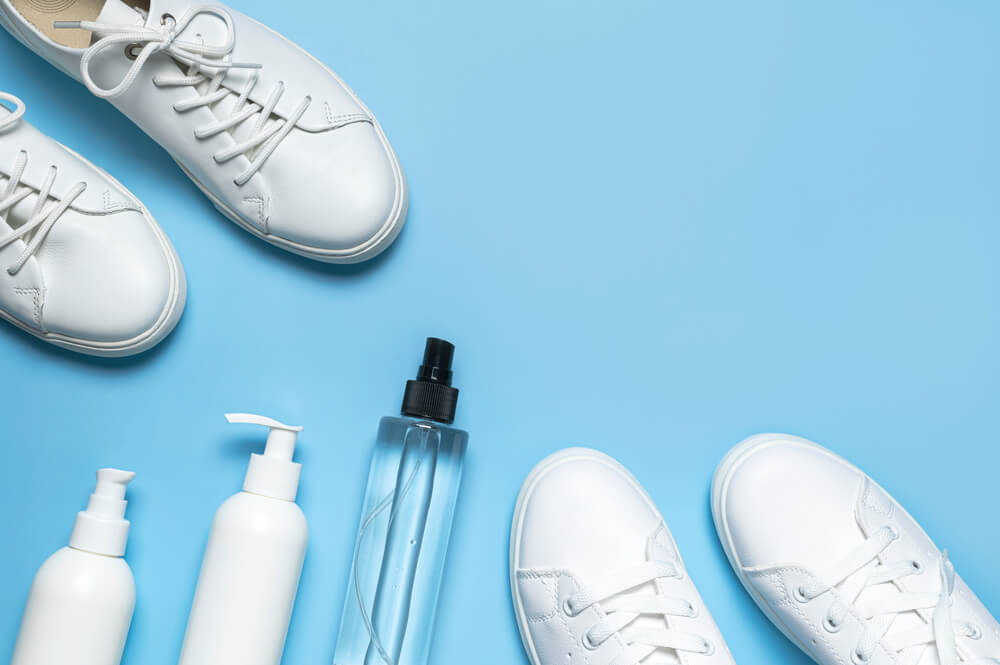Introduction
Investing in a pair of leather sneakers can be a fantastic addition to your wardrobe. However, maintaining their pristine condition requires a bit of effort. This guide serves as a comprehensive resource to help you understand the process of cleaning and conditioning leather sneakers. By following these steps, you can ensure that your investment lasts, keeping your footwear looking fresh and stylish for years to come. Here’s our guide to leather sneaker care.
The Importance of Proper Leather Sneaker Care

Proper care for your leather sneakers is not only vital for maintaining their aesthetic appeal, but it also prolongs their lifespan and enhances comfort. Leather, as a natural material, can dry out, crack, and deteriorate if not properly maintained. This can lead to discomfort and premature wear and tear.
Regular cleaning removes dirt and stains that could otherwise mar the leather’s surface, while conditioning keeps the material flexible, preventing creasing and cracking. Moreover, well-maintained sneakers demonstrate a sense of style and attention to detail, adding to your overall appearance.
Therefore, investing time and effort into proper leather sneaker care is just as crucial as the initial investment in the shoes themselves.
Understanding Leather Shoes
Different Types of Leather Used in Sneakers
Leather used in sneakers often falls into three main categories: Full-Grain Leather, Top-Grain Leather, and Genuine Leather.
Full-Grain Leather is the highest quality of leather available. It’s the full, unprocessed hide from the animal, which includes the grain and all the natural markings. This type of leather is robust, durable, and develops a rich patina over time. However, it’s also the most expensive.
Top-Grain Leather, on the other hand, has been lightly sanded or buffed to remove imperfections, resulting in a more uniform, albeit less durable surface compared to Full-Grain. It’s a great balance of quality and cost, making it a popular choice for many sneaker brands.
Lastly, Genuine Leather is a term that generally refers to lower-quality leather. It’s made from the leftover parts of the hide once the top is removed. This type of leather is much softer and less durable, but it’s also the most affordable.
Each type of leather has its characteristics and benefits, and the choice largely depends on the wearer’s preference, lifestyle, and budget.
How Leather Sneakers Differ from Other Materials

Leather sneakers offer advantages that set them apart from shoes made from other materials. Firstly, leather’s durability is unmatched. Unlike synthetic materials, leather withstands wear and tear for an extended period, providing excellent value for your investment.
Secondly, leather is breathable, which makes it less likely to retain odour compared to shoes made from synthetic materials, contributing to improved foot health. Thirdly, leather molds to your foot over time, offering a personalized fit that enhances comfort. Finally, the aesthetic appeal of leather is timeless.
Leather sneakers offer a sophisticated, versatile style that easily transitions from casual to formal settings. However, they do require more maintenance than sneakers made from synthetic materials, which often can be simply wiped clean or machine washed.
Cleaning Leather Sneakers

Preparing the Sneakers for Cleaning
Before you begin cleaning your leather sneakers, it is essential to prepare them properly. Start by removing the laces and inserts, setting them aside for separate cleaning. This ensures that all parts of the shoe get properly cleaned and conditioned, and it prevents unnecessary soaking of laces and inserts.
Next, use a soft shoe brush or a dry cloth to dust off surface dirt and debris from the sneakers. Brush gently but thoroughly, paying special attention to the crevices and hard-to-reach areas where dirt tends to accumulate. This preliminary cleaning step is vital as it prevents dirt from getting spread around during the wet cleaning process.
Preparing your shoes in this way makes the cleaning process more effective and helps maintain the integrity of the leather. Ensuring that your sneakers are debris-free makes the subsequent steps easier and more productive. For additional tips, check out our guide for how to clean white sneakers.
Choosing the Right Cleaning Products

Choosing the right cleaning products for your leather sneakers is crucial in maintaining the material’s condition.
Mild Leather Cleaner
A mild leather cleaner should be your go-to choice because it’s designed to gently cleanse the leather without stripping it of its natural oils, which are essential for maintaining flexibility and preventing cracking.
Soft Bristle Brush
When applying the cleaner, it is highly recommended to use a soft bristle brush. The gentle and supple bristles of the brush effectively work the cleaner into the intricate grain of the leather, ensuring thorough cleaning without any risk of scratching or damaging the surface. This careful approach helps preserve the luxurious look and feel of the leather, keeping it in impeccable condition for years to come.
Microfiber Cloth
After cleaning, a microfiber cloth is ideal for wiping the shoes down. Its fine fibers are capable of picking up any residual dirt and cleaner without leaving behind lint or causing unnecessary abrasion.
Remember, leather is a delicate material that requires gentle handling. Using harsh cleaning tools or products can cause irreparable damage, so always opt for mild cleaners and soft tools for the best results.
Step-by-Step Cleaning Process
Test the Cleaner on a Small Area
Before applying any cleaner to the entire surface of your leather sneakers, it’s crucial to conduct a spot test. Apply the cleaner to a small, inconspicuous area and wait for a few minutes, observing for any negative reactions such as discolouration, drying, or texture changes.
This step is important as it helps you avoid potentially damaging the whole shoe with a cleaning product that is too harsh or not suitable for your specific type of leather. The diversity in leather types and the varying chemical compositions of cleaning products make this preliminary test a vital part of the cleaning process.
Apply the Cleaner and Work it into the Leather
After confirming the suitability of your cleaner through a spot test, you are now ready to clean your sneakers. Pour a small amount of the cleaner onto your soft bristle brush. Begin by gently applying the cleaner to the surface of the leather, using circular motions to work it into the material.
This technique ensures that the cleaner penetrates into the grain of the leather, effectively lifting off dirt and grime. It’s essential to maintain a gentle touch to avoid scratching or damaging the leather. After you have worked the cleaner over all the surfaces of your shoe, let the cleaner sit for a few minutes to further break down any stubborn dirt.
Wipe off Excess Cleaner and Rinse if Required
Next, take your microfiber cloth and gently wipe away the cleaner, using circular motions for optimal results. This technique effectively eliminates the lifted dirt along with the cleaning solution. To maintain the cloth’s cleanliness, rinse it frequently with water and wring it out before continuing to wipe.
Dry the Sneakers Properly
After wiping off all the cleaner, allow the sneakers to air dry naturally. Keep them away from direct sunlight or heat sources to prevent any cracking of the leather. Following this process will leave your leather sneakers clean, refreshed, and ready for conditioning.
Conditioning Leather Sneakers
Importance of Conditioning
Conditioning leather sneakers is an often overlooked but vital aspect of their maintenance. Leather, a natural material, contains oils that keep it flexible, durable, and looking its best. Over time, these oils can deplete, especially after a thorough cleaning. This can lead to the leather drying out, becoming brittle, and eventually cracking.
Conditioning replenishes these essential oils, restoring flexibility and preventing premature aging of the leather. Furthermore, a good leather conditioner can provide a protective barrier against water, dirt, and stains, extending the life and enhancing the appearance of your leather sneakers.
Thus, conditioning is not just a maintenance step, but it’s a necessity if you want your leather sneakers to retain their aesthetic appeal and longevity. So be sure to add this vital step to your leather sneaker care routine.
How to Apply Leather Conditioner
Just like cleaning, applying conditioner to your leather sneakers requires a careful, step-by-step approach.
Test the Conditioner on a Small Area
Before applying the conditioner to your sneakers, it’s crucial to do a spot test. Apply a tiny amount of the conditioner to an inconspicuous area of the shoe, and observe for any negative reactions such as discoloration or changes in texture. This ensures that the conditioner is suitable for your particular type of leather.
Apply the Conditioner
If the spot test is successful, you can proceed to apply the conditioner. Using a soft, clean cloth, apply a small amount of conditioner to the surface of the leather. Rub it in gently, ensuring it penetrates the entire surface of the shoe. Take care to avoid over-saturating the leather, as this may cause it to become overly soft and lose its shape.
Let the Conditioner Absorb
After applying the conditioner, let your sneakers sit for about 15-20 minutes. This allows the conditioner to fully penetrate the leather and replenish its natural oils.
Buff away Excess Conditioner
Finally, using another clean, dry cloth, gently buff off any excess conditioner from the surface of the sneakers. This leaves your shoes looking shiny and prevents them from attracting dust and dirt.
Once you’re done conditioning your leather sneakers, they are ready to be worn again. With the leather renewed and protected, your sneakers will continue to look their best for many more wears to come.
Additional Tips for Leather Sneaker Care
Regular Maintenance
Regular dusting and brushing can help keep your leather sneakers looking fresh. Using a soft brush, dust off any surface dirt daily. This prevents the dirt from embedding into the leather grain, thus saving your shoes from unnecessary, frequent deep cleaning.
Storage
Always store your leather sneakers in a cool, dry place out of direct sunlight. Excessive exposure to heat or sunlight can cause the leather to dry out and crack. If possible, use shoe trees to help maintain the shape of your sneakers when not in use.
Rotate Your Sneakers
Giving your sneakers a day off in between wears allows the leather to breathe and moisture to evaporate. This prevents the buildup of bacteria and extends the life of your shoes.
Use a Leather Protectant
Spray-on leather protectants are available that can provide an added layer of defense against dirt and water. These can be applied after the conditioning process.
Replacing Insoles
Consider replacing the insoles of your sneakers periodically. This can help maintain the freshness of your shoes and can also provide added comfort and support.
By following these additional tips, you can ensure your leather sneakers remain in top-notch condition for a long duration, maintaining their aesthetic appeal and structural integrity. For more tips and tricks, you can read our article on how to ensure the longevity of your shoes.
Conclusion
In conclusion, leather sneakers, when properly cared for, can retain their luxurious appeal and durability for an impressive length of time. They are more than just a fashion statement; they are an investment. The longevity and beauty of these shoes are largely dependent on the attention we give to their maintenance.
By cleaning, conditioning, and incorporating the additional steps outlined in this guide, you can preserve the life and enhance the appearance of your leather sneakers. Give your sneakers the care and respect they deserve, and in return, they will serve you well, providing comfort, style, and an enduring testament to your taste. Remember, the life of your leather sneakers is quite literally in your hands. Thanks for reading our guide to leather sneaker care.






